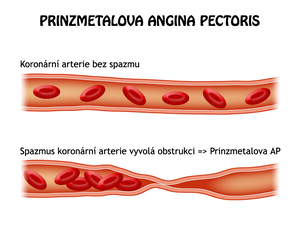Prinzmetal's angina pectoris
Prinzmetal's angina pectoris (variant AP, vasospastic AP, angina pectoris inversa) is a specific type of angina pectoris.
- Occurs as a result of 'spasm of epicardial coronary vessels (spasm can affect two or more coronary vessels at the same time).
- On EKG we observe transient ST segment elevation'.
It was first described in 1959 by the American cardiologist Myron Prinzmetal.[1]
Etiopathogenesis[edit | edit source]
Vasoconstrictive stimulus (histamine, serotonin, ergonovine, acetylcholine, noradrenaline, blood pH) + local hyperreactivity of coronary arteries to vasoconstrictive stimulus → epicardial spasm coronary arteries.[2][3]
Most coronary spasms are clinically manifested as angina pectoris and resolve spontaneously. However, longer-lasting spasms can result in myocardial infarction, arrhythmia or sudden cardiac death.[3]
Clinical symptoms[edit | edit source]
A typical symptom is angina. Their occurrence is often significantly higher depending on the weather and season; they are more common in autumn and winter in dry weather. Prinzmetal's AP can also cause a variety of arrhythmias' (from AV block to ventricular fibrillation).[3]
Diagnosis[2][3][edit | edit source]
- Prinzmetal's AP is not tied to physical activity. Angina occurs most often at night (median is 4 am).
- During an episode of angina, we observe ST elevation (or ST depression, inversion or pseudonormalization of the T wave) on the ECG. Holter monitoring can be used to capture ST elevation.
- Provocation tests: provocation with acetylcholine, methacholine, methylergonovine; provocation by exercise, cold, hyperventilation (hyperventilation echocardiography – the patient is allowed to hyperventilate during the echocardiography, which can initiate a coronary spasm, which is subsequently manifested by a disturbance in the kinetics of the ischemic region of the myocardium).
In the case of a negative coronary angiographic examination, ST elevation capture during the attack is sufficient for the diagnosis of Prinzmetal's AP.
Treatment[edit | edit source]
Pharmacological therapy is similar to classical AP. Antiplatelet therapy is controversial.
- Healthy lifestyle + elimination of provoking factors' (smoking, alcohol, cocaine, emotional stress, hyperventilation, hypomagnesemia, severe cold).
- Pharmacotherapy (calcium channel blockers, nitrates, α-blockers).
- Intracoronary stenting.
- Sympathectomy (in resistant patients).
Links[edit | edit source]
Related Articles[edit | edit source]
References[edit | edit source]
- ↑ PRINZMETAL, M – KENNAMER, R – MERLISS, R. Angina pectoris. I. A variant form of angina pectoris; preliminary report. Am J Med [online]. 1959, vol. 27, p. 375-88, Available from <https://www.ncbi.nlm.nih.gov/pubmed/14434946>. ISSN 0002-9343.
- ↑ a b FEDORCO, Marian. , et al. Variant (Prinzmetal's) angina as a less frequent cause of cardiac syncope. Cor et Vasa. 2008, y. 50, vol. 9, p. 348-351, ISSN 1803-7712.
- ↑ a b c d ROCK, T .. , et al. Malignant arrhythmia in a patient with variant (Prinzmetal's) angina pectoris. Inside Medicine. 2007, y. 53, vol. 6, p. 724-728, ISSN 0042-773X.
References[edit | edit source]
- ASCHERMANN, Michael, et al. Cardiology. 1. edition. Prague : Galen, 2004. vol. 2. pp. 1183-1185. ISBN 80-7262-290-0.
- VOKURKA, Martin. The Great Medical Dictionary. 8. edition. Prague : Maxdorf, 2009. 1143 pp. ISBN 978-80-7345-166-0.


